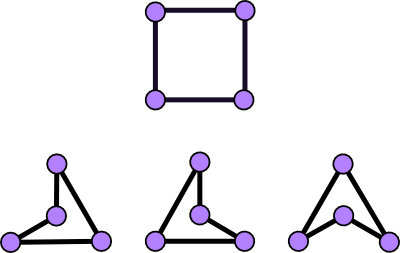For any positive integer $n$ greater than $3$, let $P(1),P(2),...,P(n)$ be a set of $n$ pairwise distinct points in the Euclidean plane, no three of which are collinear. Let $H(P(1),P(2),...,P(n))$ be the set of simple closed (not necessarily convex) polygons whose set of vertices is exactly the set $P(1),P(2),...,P(n)$. Partition $H(P(1),P(2),...,P(n))$ into equivalence classes, with two polygons in the same class just in case they are congruent. Let $N(P(1),P(2),...,P(n))$ be the number of these equivalence classes. Is $H(P(1),P(2),...,P(n))$ always non-empty? For which positive integers $n$ greater than 3, has the maximum possible value of $N(P(1),P(2),...,P(n))$ been computed-where the maximum is to be taken over all sets of n pairwise distinct co-planar points, no three of which are collinear?
1 Answer
$\begingroup$

The maximum number (your $N$) of polygonizations of a $n$-point set $P$ is $c^n$ for $c$ somewhere between about $4.6$ and $56$.

(Image from Erik Demaine's webpage.)
$\endgroup$
2
What you call set $H$ is the set of simple polygonalizations of the $n$ points $P$. $H$ is only empty if all $n$ points are collinear. For one may form a star-shaped polygon by selecting a point $x$ in the convex hull, not in $P$ and not collinear with any two points of $P$, and connecting $P$ in angular order around $x$:

The maximum number (your $N$) of polygonizations of a $n$-point set $P$ is $c^n$ for $c$ somewhere between about $4.6$ and $56$.

(Image from Erik Demaine's webpage.)
-
$\begingroup$ Many thanks. That is a very nice way of getting a simple closed polygon through those n points. I wonder if it could be made to work in higher dimensional Euclidean spaces. I was also surprised ton learn that there is an actual formula for the maximum as a function of n. It looks like an asymptotic formula. Or is it just an upper bound. It is certainly an improvement on the crude upper bound n! $\endgroup$ Commented Oct 14, 2015 at 22:34
-
$\begingroup$ @GarabedGulbenkian: Just a crude upper bound. It is a very difficult problem to get an exact bound, tied up with the # of triangulations of a point set. Yes, there is an extension to $\mathbb{R}^3$ and higher dimensions, less explored. $\endgroup$ Commented Oct 14, 2015 at 22:37
